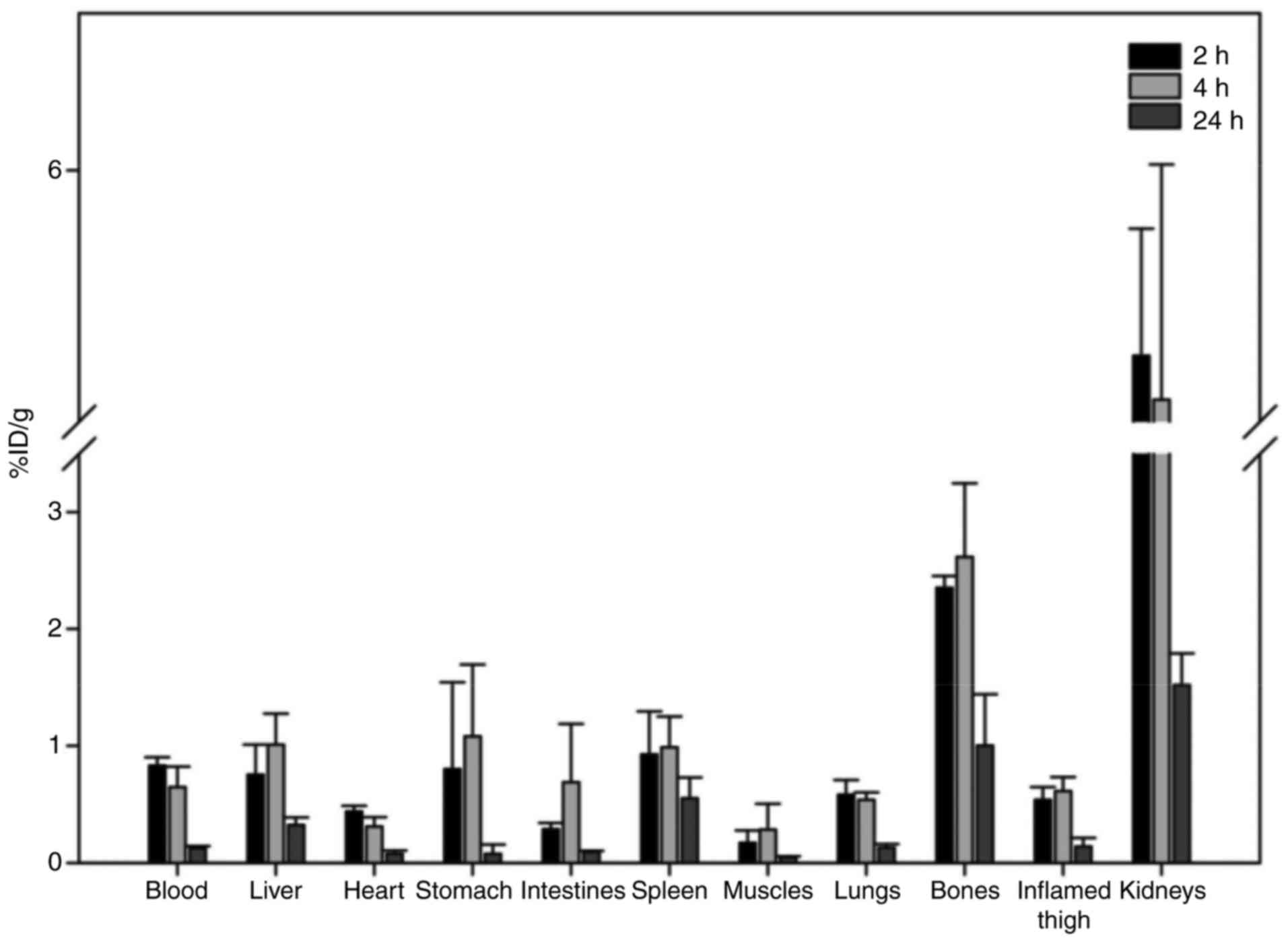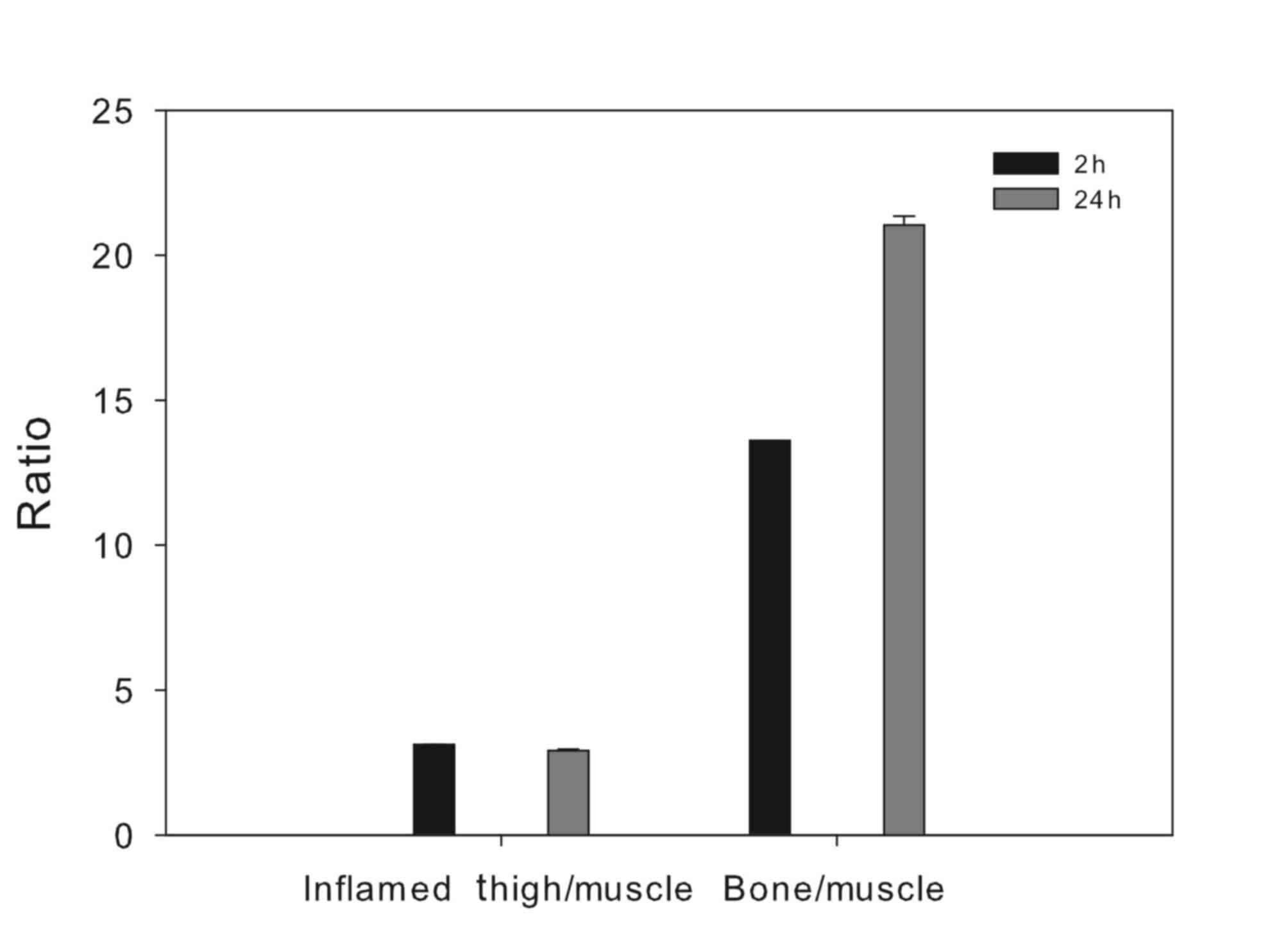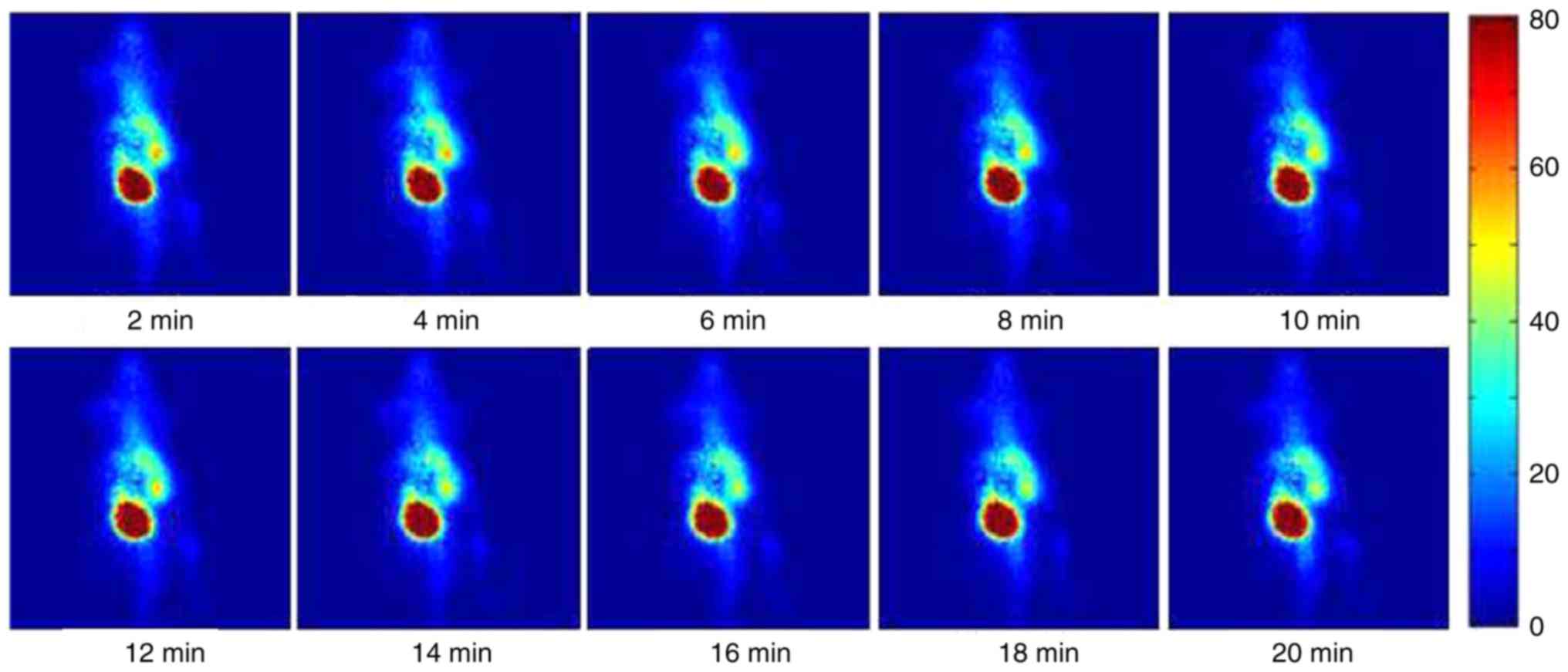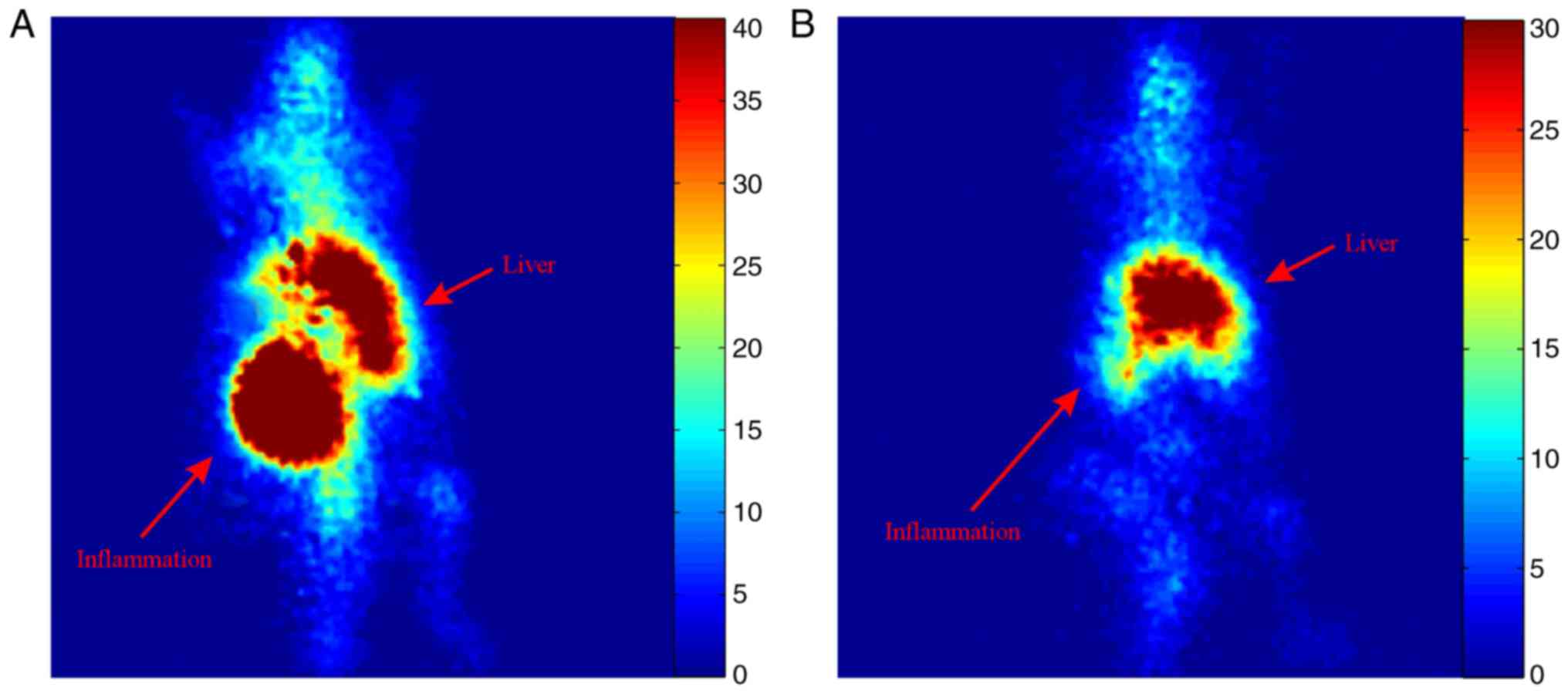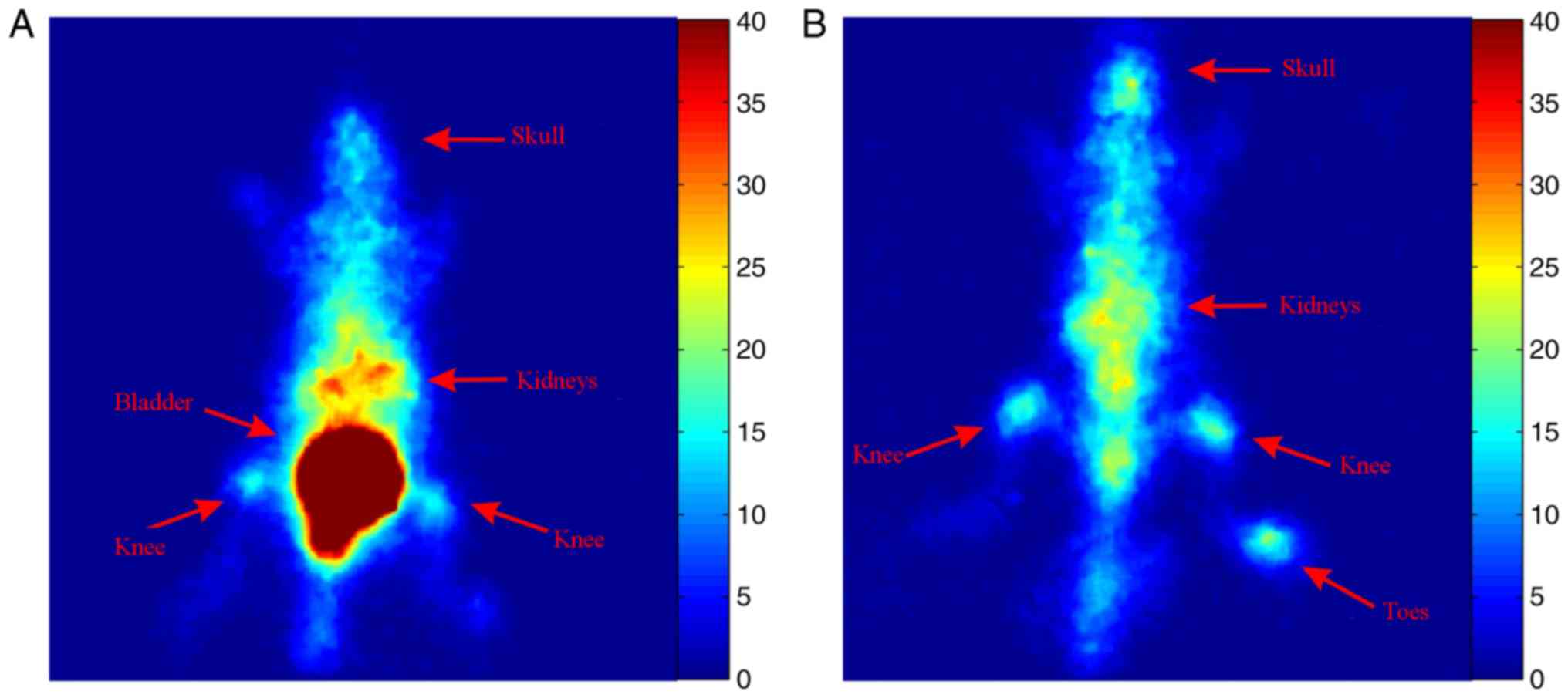Radiolabeled methotrexate as a diagnostic agent of inflammatory target sites: A proof-of-concept study
- Authors:
- Published online on: November 27, 2017 https://doi.org/10.3892/mmr.2017.8166
- Pages: 2442-2448
-
Copyright: © Papachristou et al. This is an open access article distributed under the terms of Creative Commons Attribution License.
Abstract
Introduction
Methotrexate {MTX; (2S)-2-[[4-[(2,4-diaminopteridin-6-yl) methyl-methylamino]benzoyl]amino]pentanedioic acid} is a structural analogue of folic acid and one of the most widely used antimetabolites in cancer chemotherapy (1). At low doses (up to 25 mg/week) it is also part of the established treatment of many autoimmune inflammatory disorders, most notable of which is rheumatoid arthritis (RA) where it has nowadays become the standard of care (2).
Folic acid is essential for the synthesis of deoxyribonucleic acids (DNA), since it is a required co-factor for the synthesis of thymidylate by the enzyme thymidylate synthetase (TS), but also plays a key role in purine metabolism, being a co-factor for the enzyme 5-aminoimidazole-4-carboxamide ribonucleotide (AICAR) transformylase. In order to be used as co-factor, folate needs to be converted to its active form by a two-step reaction that reduces folate first to dihydrofolate and subsequently to tetrahydrofolate (FH4). This last reaction is catalysed by the enzyme dihydrofolate reductase (DHFR) (3,4).
MTX inhibits DHFR, thus, it inhibits both TS and AICAR transformylase. In this way, MTX interferes with DNA synthesis, repair, and cellular replication, ultimately causing limitation of the high turnover of inflammatory cells. On the other hand, MTX-polyglutamates (MTX-glu) are long-lived metabolites of MTX, which reside in a variety of tissues, such as liver, erythrocytes and adipose tissue. They persist for weeks to months, and this is considered to be the key factor behind the slow onset and prolonged duration of the anti-inflammatory effects of MTX. In fact, it takes about a week for the onset of the anti-inflammatory effects, while MTX is almost undetectable 24 h after administration (3).
MTX-glu causes accumulation of AICAR, due to the AICAR trasformylase inhibition, and its metabolites, which are inhibitors of adenosine deaminase and AMP deaminase, ultimately leading to elevated levels of both intracellular and extracellular adenosine. When MTX is administered at low doses, it induces elevated levels of extracellular adenosine, which mainly binds to A2 receptors and leads to increased intracellular cAMP, thus, leading to immunosuppression via inhibition of phagocytosis, lymphocyte proliferation and of the secretion of various cytokines (4,5).
Other proposed actions of MTX in the treatment of RA include reduction of various cell adhesion molecules' expression, indirect inhibition of osteoclast formation and probably some indirect anti-angiogenetic effects (6).
MTX has been studied as a tumor-diagnostic agent in a number of published studies, by either direct labelling with technetium-99m (99mTc) (7–9) or as a mercaptoacetyltriglycine-MTX (MAG3-MTX) conjugate labelled with 99mTc (10). The purpose of this study is to present the possible use of 99mTc-labelled MTX as a radiotracer for the identification of inflammatory target sites, which are associated with RA in joints, bones and tissues.
Materials and methods
All chemicals employed for this research were of analytical grade. Stannous chloride, ascorbic acid and sodium bicarbonate were purchased from Aldrich, USA. The 99mTc-generator was purchased from GE Healthcare. MTX was purchased from Pfizer (Athens, Greece). Saline and water for injection were purchased from Demo (Athens, Greece).
High-performance liquid chromatography (HPLC) analyses were performed on a Waters µ-Bondapack C18 (3.9 mm i.d. ×300 mm) cartridge column (Waters GmbH, Eschborn, Germany). The gradient system employed is described below. Solvents for HPLC were of analytical grade, and were filtered through 0.22 µm membrane filters (EMD Millipore, Billerica, MA, USA) and degassed. Radioactivity measurements were recorded on an automated well-type γ-counter NaI(Tl) crystal (Packard).
Animal experiments were carried out according to European and National regulations. Biodistribution studies were performed using female normal Swiss mice (20±2 g) of the same colony and age, purchased from the Breeding Facilities of the Institute of Biosciences and Applications, NCSR ‘Demokritos’.
Radiolabeling and radiochemical purity analysis
The labelling of MTX was performed by ligand exchange from a 99mTc(v)O-gluconate precursor. Sodium gluconate acts as an intermediate exchange ligand for 99mTc, with stannous chloride as the reducing agent (11). Briefly, a solid mixture of 1 g sodium gluconate, 2 g of sodium bicarbonate and 15 mg of stannous chloride was homogenized and kept under anhydrous conditions. 3 mg of this mixture were dissolved in 1 ml of a sodium pertechnetate solution (Na99mTcO4) containing 296 MBq/8 mCi 99mTc. 10 mg of MTX were added, and the mixture was stirred for 30 min at room temperature. The pH of the final solution was 7.
Radiochemical control of the 99mTc-MTX complex was carried out with Instant Thin Layer Chromatography-Silica Gel (ITLC-SG) in saline and Whatman 3 mm chromatography paper (PC) in acetone. Briefly, 2 µl of the reaction mixture were applied on Silica Gel (ITLC-SG) and Whatman 3-mm strips. The radiochromatographs were developed in saline (0.9% NaCl) and acetone, respectively, over a distance of 10 cm. After drying, the strips were cut in 1-cm pieces and their radioactivity was counted in a well-type scintillation counter. Furthermore, Reversed-Phase HPLC (RP-HPLC) analysis was performed on an aliquot of the reaction solution, by applying the following linear gradient system: From 0 to 80% solvent B (1–20 min), 80% solvent B (20–23 min), 80 to 0% solvent B (23–25 min) and 0% solvent B (25–30 min), at a 0.8 ml/min flow rate (solvent A: 0.1% Trifluoroacetic Acid (TFA) in H2O; solvent B: 0.1% TFA in Acetonitrile (AcCN).
In vitro stability and protein binding
In vitro stability of 99mTc-MTX at room temperature was assessed up to 24 h after preparation of the sample. Plasma stability was carried out in fresh human plasma at 37°C. For preparation of human plasma, a blood sample from healthy donors was collected in heparinised polypropylene tubes and was immediately centrifuged at 2,000 × g for 10 min. The supernatant was collected and used for the stability study. 100 µl (~29.6MBq/0.8mCi) of 99mTc-MTX was incubated with 900 µl of plasma at 37°C. At 2 and 4 h, 100-µl aliquots were treated with a two-fold excess of ethanol and centrifuged at 1,000 × g for 15 min. The remaining pellet was washed thrice with 1 ml EtOH, and these ethanolic washes were combined with the supernatant and counted in a γ well counter. This activity was compared to the activity in the pellet, to give the percentage of 99mTc-MTX not bound to proteins. The supernatant was analysed by paper chromatography and ITLC, as described above.
Determination of partition coefficient
The apparent partition coefficient for 99mTc-MTX was determined by mixing aliquots of the technetium complex with 1-octanol and phosphate buffer (0.125 M, pH 7.4).
In a centrifuge tube, containing 2 ml of each phase, 100 µl of the 99mTc complex solution was added, and the mixture was agitated on a Vortex mixer for approximately 1 min and finally centrifuged at 5,000 × g for 5 min. Three samples (0.2 ml each) from each layer were counted in a γ counter. The partition coefficient was calculated as the mean value of each cpm/ml of octanol layer divided by that of the buffer. A sample (1.0 ml) from the octanol layer was subsequently repartitioned in octanol/buffer until constant values were obtained. This was achieved with the third repartition.
Biodistribution studies
All applicable institutional and/or national guidelines for the care and use of animals were followed. These studies were approved by the Ethics Committee of the National Center for Scientific Research of ‘Demokritos’ (Athens, Greece) and animal care and procedures followed are in accordance with institutional guidelines and licenses issued by the Department of Agriculture and Veterinary Policies of the Prefecture of Attiki (Registration nos. EL 25 BIO 022 and EL 25 BIO 021). Mice were housed under constant environmental conditions with 12 h light-dark cycles and had free access to food and water. To induce inflammation, animals were inoculated with 50 µl of pure turpentine oil subcutaneously in the left thigh muscle under slight ether anaesthesia (11,12). All animals developed an oedema 18 to 24 h after turpentine inoculation, which was visible to the naked eye.
Ex vivo animal experiments were performed in Swiss Albino mice with experimentally-induced inflammation (20±2 g, n=3 animals per time-point), by injecting 100 µl (3.7 MBq/0.1 mCi) of the radiotracer via the tail vein. Animals were sacrificed by cardiectomy under slight ether anaesthesia at 2, 4 and 24 h post injection, and the main tissues and organs (blood, heart, liver, stomach, intestines, spleen, lungs, pancreas and bones) were excised, blotted dry and weighed. The inflamed thigh was excised and trimmed of the neighboring subcutaneous tissue. The muscle of the non-inflamed right thigh was also excised, for reasons of comparison. Samples were counted in a gamma counter (NaI gamma counter; Packard, Downers Grove, IL, USA). Standards were prepared from the injected material and were counted each time simultaneously with the tissues excised, allowing for calculations to be corrected for physical decay of the radioisotope. Radiolabeled MTX distribution over time was expressed as injected dose per gram (%ID/g).
Imaging system
The imaging system employed is a compact, Anger-type, γ-ray camera developed at the Center for Gamma-Ray Imaging of the University of Arizona. Details of the system can be found elsewhere (13–15). Briefly, the system comprises a 5 mm thick NaI(Tl) scintillation crystal, a 12 mm thick quartz light guide, a 3×3 array of 1.5 inch diameter photomultiplier tubes (PMTs), and a 40-mm thick lead parallel-hole collimator with hexagonal holes of 1-mm in diameter. The system achieves a spatial resolution of approximately 2.5 mm at the collimator face and degrades linearly with distance. The field-of-view of the camera is 4.5 in × 4.5 in, enough to image a whole mouse without axially moving the camera or the mouse.
Image acquisition
A Swiss mouse, with experimentally-induced inflammation for 24 h in the left hind limb area, was anesthetized with an intraperitoneal (IP) injection of ketamine (75 mg/kg) and xylazine (5 mg/kg) and placed on the camera face in the prone position. The animal was injected with 100 µl (25.9 MBq/0.7 µCi) of 99mTc-MTX. Dynamic planar scintigraphy was performed by collecting 10 consecutive two-minute images, for a total period of 20 min. Two h after tracer injection, additional anaesthesia was applied and a 5-min static image was collected with the animal in the same position. Furthermore, 24 h after injection the animal was euthanized and a 1 h image was acquired.
Binding studies on hydroxyapatite
Hydroxyapatite binding studies were performed in vitro to simulate the binding of the radiotracer under investigation to bone structure. For this purpose, hydroxyapatite (Hap; Sigma-Aldrich; Merck KGaA, Darmstadt, Germany) was suspended in isotonic saline at 20 mg/ml and then incubated for 24 h at room temperature. The following day, 50 µl (0.444MBq/0.012mCi) of 99mTc-MTX were added to the Hap fractions. After a 10s vortex, the sample was incubated, under agitation, for 10 min at room temperature and centrifuged. The supernatant was then removed and the Hap fraction was washed twice with saline. The radioactivity of the Hap fraction and the saline washes were then measured with a well-type gamma counter. Control experiments were performed using 99mTc-MTX, without Hap. 99mTc-MTX binding to Hap was determined as percent of absorbed onto Hap [Hydroxyapatite binding (%)=(radioactivity of Hap fraction of each sample/total radioactivity)x100].
Results
Radiolabeling and radiochemical purity analysis
Radiolabeling of MTX was achieved by the preconjugation approach, via the precursor 99mTc-gluconate. Radiochemical purity was assessed by paper chromatography (Whatman 3 MM) and ITLC-SG. With ITLC-SG, 99mTc-MTX and the free pertechnetate 99mTcO4-appeared at Rf=0.9–1.0, while 99mTcO2 was detected at Rf=0.0–0.1. In acetone the free 99mTcO4 had an Rf of 0.9–1.0 while the 99mTc-MTX and the hydrolysed99mTcO2 appeared at Rf=0.0–0.1. The radiochemical purity of 99mTc-MTX was found to be 95–98%. Under the specific HPLC conditions, there was one product peak of 99mTc-MTX moving with the solvent front, with a retention time of approximately 20 min, while the retention times of 99mTcO4− and 99mTc-gluconate were <5 min (9).
In vitro stability and protein binding
The stability of 99mTc-MTX was determined by paper chromatography and ITLC at different time points, as described above. The radiolabeled complex remained stable (up to 90%) at room temperature, for up to 24 h post-labelling. Plasma stability studies showed that 94.9±1.2% of 99mTc-MTX remained intact at 2 h, dropping to 85.8±2.7% at 4 h post-incubation.
Before performing ex vivo biodistribution studies in mice, the in vitro binding of 99mTc-MTX was assessed in human plasma. Protein binding in human plasma was found to be 48.1±1.9% at 2 h, remaining practically stable at 4 h post-incubation (49.1±2.2%).
Determination of partition coefficient
Regarding lipophilicity, the partition coefficient indicated that 99mTc-MTX had maximum extraction in phosphate-buffered saline (PBS), pH 7.4 (hydrophilic medium), while a negligible amount of activity was observed in octanol (lipophilic medium), thus suggesting that radiolabeled drug was hydrophilic in nature. The logP value was estimated to be −2.28±0.03.
Biodistribution studies
The biodistribution of 99mTc-MTX was assessed on Swiss Albino mice with experimentally-induced inflammation at 2 and 24 h post injection (Fig. 1). Rapid clearance from blood and predominant excretion via the urinary system was observed for the radiotracer. Uptake in the stomach and spleen was low, providing evidence for the in vivo stability of the tracer. With regard to the other organs, apart from the kidneys, no major uptake was observed in all analysed tissues (≤1.0% ID/g from 2 h post injection). An important observation was the increased uptake of the radiotracer in the inflamed muscle, in comparison to the contralateral normal muscle tissue (0.54±0.11 vs. 0.17±0.10; 0.61±0.12 vs. 0.28±0.22; and 0.14±0.07 vs. 0.05±0.01 at 2, 4 and 24 h post injection, respectively), with the inflammation-to-normal muscle ratio remaining practically stable up to 24 h post injection. Furthermore, an unexpected observation was the significant bone uptake observed, which led to a pronounced differentiation between bone and non-osseous tissue, especially at 24 h post injection (Fig. 2).
Imaging studies
A dynamic sequence of γ-ray images of an inflammation-induced mouse injected with 25.9 MBq (0.7 mCi) of 99mTc-MTX at consecutive time points is presented in Fig. 3. All images are 2-min acquisitions and they are displayed on the same colour scale. The colour intensity represents the magnitude of the deposited radiotracer. The inflammation site, in the left side of the animal, is clearly identified by visual inspection immediately after injection. Liver uptake of the tracer is also observed at a lower concentration than the inflammation site.
Static planar scintigraphic images of the mouse at 2 and 24 h post injection are shown in Fig. 4. Increased uptake of the tracer can be visually identified in the inflammation site as well as the liver 2 h post injection. At 24 h post injection most of the tracer remains at the liver with very small uptake at the inflammation site. However, some uptake at the joints and spine is also observed both at 2 and 24 h after injection.
To assess the uptake of 99mTc-MTX at the bones and joints, a healthy mouse was injected with 0.7 mCi of 99mTc-MTX and planar images were acquired 2 and 24 h later. Increased uptake of the tracer was observed at the spine, the knees and the toes of the hind-limbs at both time points (Fig. 5).
Hydroxyapatite-binding assay
Hydroxyapatite binding of 99mTc-MTX was determined on a 20 mg/ml saline sample of Hap, and was found to be 44.9±1.3%, at 10 min post incubation. In the control experiments, we confirmed that the radioactivity adsorbed to the vials was less than 0.1%.
Discussion
MTX was first developed as a cancer treatment drug in the 1940, but won FDA approval for treating RA in the late 1980s. Since then, MTX has become the treatment of choice for people with this condition, as well as for other forms of inflammatory arthritis. In the present work, MTX radiolabeled with technetium-99m has been used to assess its capacity in imaging experimentally-induced inflammation in mice. Radiolabeling of MTX with Technetium-99m using gluconate as the transfer ligand gave comparable results to the work described by other groups (7,10), in terms of radiolabeling yield and stability of the radiolabeled product. With regard to the preparation of 99mTc, our method is much more facile and straightforward (10). Stability studies were performed to evaluate whether 99mTc-MTX is stable enough in plasma to ensure sufficient delivery of radioactivity to the site of interest, as only free (i.e., non-protein bound) radiotracer is available to diffuse out of the vasculature and localize in the organism. The stability of 99mTc-MTX was determined in vitro in human plasma, where it was shown that it remained intact up to 85% after 4 h. Plasma protein binding was found to be 48.1±1.9% at 2 h, remaining practically stable at 4 h post-incubation (49.1±2.2%).
The lipophilicity of 99mTc-MTX was determined by measuring its distribution between n-octanol and PBS, pH 7.4, and resulted in a logP value of −2.28±0.03, which is comparable to results of other groups. Indicatively we would like to refer to the work of Okarvi et al (10), who showed logP values of −2.01 and −1.90, demonstrating a low lipophilicity of their 99mTc-MTX compounds. Our results showed that 99mTc-MTX is hydrophilic in nature, thus rapidly reaching the target area and exhibiting satisfactory clearance characteristics.
Biodistribution studies showed fast blood clearance, low hepatobiliary uptake and excretion via the urinary tract. The inflamed thigh showed higher radiotracer accumulation than the contralateral normal tissue, with an inflammation/muscle ratio of 3.12±0.003 at 2 h post injection, slightly dropping to 2.92±0.05 at 24 h post injection.
Planar imaging concurred with our biodistribution studies, with increased uptake at the inflammation area. However, increased uptake was also observed in the joints and spine, both areas with a relatively high remodelling activity. This prompted us to perform hydroxyapatite binding studies and a new planar scintigraphic study on a healthy mouse (without inflammation) after this pronounced uptake of 99mTc-MTX in the bone. The hydroxyapatite binding studies showed 45% binding of the tracer to the synthetic material, thus confirming the results of our biodistribution studies. Furthermore, the imaging study confirmed increased uptake of 99mTc-MTX in the spine and knee joints both at 2 and 24 h after injection (Fig. 5). These results combined with scintigraphic imaging results in the literature (16) might support the hypothesis that MTX has a diphosphonate-like behavior at least in the first 24 h, but further experiments are needed for clarification of these findings.
The interesting findings of our study have prompted us to further investigate 99mTc-MTX as a radiotracer for RA, as well as to demonstrate the efficacy of MTX before it is prescribed as a therapeutic agent for RA. If RA lesions accumulate radiolabeled MTX, these patients could be candidates for MTX therapy, while if the lesions are not addressed, the physician may proceed to the next line of treatment, without delays due to ineffective treatment. It is clear that a test which could predict adequate candidates for MTX treatment and response to MTX therapy would be welcomed by the rheumatology community. This might be of greater interest now that RA has been recognized as a major adverse event of immune checkpoint-inhibitor treatments for cancer (17).
MTX has been successfully labelled with 99mTc, with a radiochemical purity of >95%. Stability was assessed in plasma, where it remained intact up to 85% at 4 h post-incubation. Preclinical ex vivo biodistribution studies as well as in vivo imaging studies have shown that 99mTc-MTX accumulates in inflammatory sites, as well as in the spine, the joints and bones, areas with relatively high remodelling activity.
To the best of our knowledge, this study is the first to report direct evidence of hydroxyapatite binding of 99mTc-MTX. This information might prove useful in the current research for bone-targeted drug delivery (18,19). The results are promising and set the stage for further study on the development and application of 99mTc-MTX as a tool for early detection and imaging of inflammation in RA.
Acknowledgements
The publication of this article was funded by the Onassis Scholars' Association of the ‘Alexander S. Onassis’ Public Benefit Foundation. Dr L. Furenlid was partially supported by The National Institutes of Health/National Institute of Biomedical Imaging and Bioengineering (grant no. P41-EB002035).
Glossary
Abbreviations
Abbreviations:
|
MTX |
methotrexate |
|
RA |
rheumatoid arthritis |
References
|
Rang HP, Dale MM, Ritter JM, Flower RH and Henderson G: Anticancer drugsPharmacology. 7th. Rang HP and Dale MM: Churchill Livingstone Elsevier; London: pp. 673–688. 2011 | |
|
Weinblatt ME: Methotrexate in rheumatoid arthritis: A quarter century of development. Trans Am Clin Climatol Assoc. 124:16–25. 2013.PubMed/NCBI | |
|
Chan ES and Cronstein BN: Mechanisms of action of methotrexate. Bull Hosp Jt Dis. 71 Suppl 1:S5–S8. 2013. | |
|
Cutolo M, Sulli A, Pizzorni C, Seriolo B and Straub RH: Anti-inflammatory mechanisms of methotrexate in rheumatoid arthritis. Ann Rheum Dis. 60:729–735. 2001. View Article : Google Scholar : PubMed/NCBI | |
|
Tian H and Cronstein BN: Understanding the mechanisms of action of methotrexate: Implications for the treatment of rheumatoid arthritis. Bull NYU Hosp Jt Dis. 65:168–173. 2007.PubMed/NCBI | |
|
Wessels JA, Huizinga TW and Guchelaar HJ: Recent insights in the pharmacological actions of methotrexate in the treatment of rheumatoid arthritis. Rheumatology (Oxford). 47:249–255. 2008. View Article : Google Scholar : PubMed/NCBI | |
|
Dar UK, Khan IU, Javed M, Ahmad F, Ali M and Hyder SW: Preparation and biodistribution in mice of a new radiopharmaceutical-technetium-99m labeled methotrexate, as a tumor diagnostic agent. Hell J Nucl Med. 15:120–124. 2012.PubMed/NCBI | |
|
Rasheed R, Javed M, Ahmad F, Sohail A, Murad S, Masood M and Rasheed S and Rasheed S: Preparation of (99m)Tc-labelled methotraxate by a direct labeling technique as a potential diagnostic agent for breast cancer and preliminary clinical results. Hell J Nucl Med. 16:33–37. 2013.PubMed/NCBI | |
|
Ozgenc E, Ekinci M, Ilem-Ozdemir D, Gundoglu E and Asikoglu M: Radiolabeling and in vitro evaluation of 99mTc-methotrexate on breast cancer cell line. J Radioanal Nucl Chem. 307:627–633. 2016. View Article : Google Scholar | |
|
Okarvi SM and Jammaz IA: Preparation and in vitro and in vivo evaluation of technetium-99m-labeled folate and methotrexate conjugates as tumor imaging agents. Cancer Biother Radiopharm. 21:49–60. 2006. View Article : Google Scholar : PubMed/NCBI | |
|
Mirzaei A, Jalilian AR, Akhlaghi M and Beiki D: Production of 68Ga-citrate based on a SnO2 generator for short-term turpentine oil-induced inflammation imaging in rats. Curr Radiopharm. 9:208–214. 2016. View Article : Google Scholar : PubMed/NCBI | |
|
Rivera S and Ganz T: Animal models of anemia of inflammation. Semin Hematol. 46:351–357. 2009. View Article : Google Scholar : PubMed/NCBI | |
|
Furenlid LR, Wilson DW, Chen YC, Kim H, Pietraski PJ, Crawford MJ and Barrett HH: FastSPECT II: A second-generation high-resolution dynamic SPECT imager. IEEE Trans Nucl Sci. 51:631–635. 2004. View Article : Google Scholar : PubMed/NCBI | |
|
Furenlid LR, Chen YC and Kim H: SPECT Imager Design and Data-Acquisition SystemsSmall-Animal SPECT Imaging. Kupinski MA and Barrett HH: Springer US; Boston, MA: pp. 115S–138S. 2005, View Article : Google Scholar | |
|
Chen YC, Furenlid LR, Wilson DW and Barrett HH: Calibration of Scintillation Cameras and Pinhole SPECT Imaging SystemsSmall-Animal SPECT Imaging. Kupinski MA and Barrett HH: Springer US; Boston, MA: pp. 195–201. 2005, View Article : Google Scholar | |
|
Rasheed R, Gillani J, Jielani A, Irum F, Lodhi N and Rasheed S and Rasheed S: Tc99m methotrexate (MTX): A novel complex for imaging of rheumatoid arthritis (RA): First clinical trials. Gen Med (Los Angel) Personalized Medicine. S2132016. | |
|
Naidoo J, Cappelli LC, Forde PM, Marrone KA, Lipson EJ, Hammers HJ, Sharfman WH, Le DT, Baer AN, Shah AA, et al: Inflammatory arthritis: A newly recognized adverse event of immune checkpoint blockade. Oncologist. 22:627–630. 2017. View Article : Google Scholar : PubMed/NCBI | |
|
Cole LE, Vargo-Gogola T and Roeder RK: Targeted delivery to bone and mineral deposits using bisphosphonate ligands. Adv Drug Deliv Rev. 99:12–27. 2016. View Article : Google Scholar : PubMed/NCBI | |
|
Raichur V, Vemula KD, Bhadri N and Razdan R: Zolendronic acid-conjugated PLGA ultrasmall nanoparticle loaded with methotrexate as a supercarrier for bone-targeted drug delivery. AAPS PharmSciTech. 18:2227–2239. 2017. View Article : Google Scholar : PubMed/NCBI |



